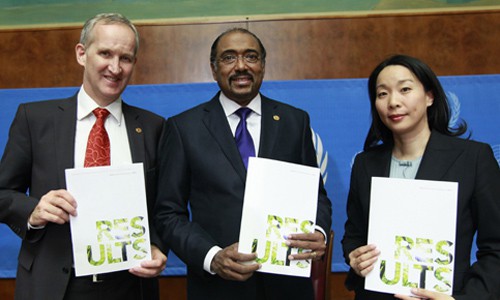
The number of people living with AIDS who have access to antiretroviral therapy increased by 63 per cent from 2009 to 2011 as greater national investment led to improved access programmes.
According to a report by the Joint United Nations Programme on HIV/AIDS (UNAIDS) to mark World AIDS day on December 1, it’s the first time a majority (54 per cent) of people eligible to receive AIDS medicines in low- and middle-income countries were actually receiving them.
This means more than 8 million people outside the most developed nations are now receiving antiretroviral therapy, a twenty fold increase from 2003 when less than 500,000 people in these countries had access.
“This accelerating pace needs to be sustained if the world is to achieve the goal of reaching 15 million people with HIV treatment by 2015,” said the report.
Central to this growth is an improvement in national AIDS programme, said the report, with programme implementers “benefiting from lessons learned over the past decade to enhance the success of treatment initiatives”.
Mozambique was highlighted as an example where improved programme monitoring helped to reduce the costs of antiretroviral therapy per person by 45 per cent from 2009 to 2011.
Such efforts have been helped by greater funding, after more than 81 low- and middle-income countries increased domestic investments by 50 per cent between 2001 and 2011.
This included South Africa, which scaled up its financial support of HIV treatments by 75 per cent, meaning 1.7 million extra people had access to medicines.
Similar increases in national support on other countries meant, for the first time ever, domestic investments from low- and middle-income countries surpassed global aid for HIV.
There is still a great diversity in access to therapy, however, with Eastern Europe and Central Asia only able to provide medicines to 25 per cent of its population with AIDS, while the figure was just 15 per cent in the Middle East and North Africa.
This compared to coverage levels of 68 per cent in Latin America, 67 per cent in the Caribbean and 56 per cent in sub-Saharan Africa.
Overall progress was positive though, with the number of countries with coverage less than 20 per cent falling from 28 in 2009 to 10 in 2011.
Going forward, the report said it is “essential” for a further reduction in the cost of medicines if UNAIDS’ targets are to be met and UNAID said that part of this should involve more countries taking advantage of the flexibilities contained in the Trade-Related Aspects of Intellectual Property Rights (TRIPS).
These flexibilities include compulsory licensing, allowing governments to produce a patented medicine without the consent of the patent owner. Developing countries are also allowed to export patented AIDS medicines to other countries where there is a national AIDS problem.
Other areas of improvement include a need for greater treatment retention rates for people enrolled in HIV care and treatment, while men should be reached earlier with HIV testing and treatment services in high-prevalence settings.




